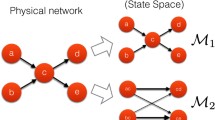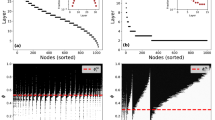Abstract
A set of analytical and computational tools based on transition path theory (TPT) is proposed to analyze flows in complex networks. Specifically, TPT is used to study the statistical properties of the reactive trajectories by which transitions occur between specific groups of nodes on the network. Sampling tools are built upon the outputs of TPT that allow to generate these reactive trajectories directly, or even transition paths that travel from one group of nodes to the other without making any detour and carry the same probability current as the reactive trajectories. These objects permit to characterize the mechanism of the transitions, for example by quantifying the width of the tubes by which these transitions occur, the location and distribution of their dynamical bottlenecks, etc. These tools are applied to a network modeling the dynamics of the Lennard–Jones cluster with 38 atoms (\(\mathrm{LJ}_{38}\)) and used to understand the mechanism by which this cluster rearranges itself between its two most likely states at various temperatures.













Similar content being viewed by others
References
Ahuja, R.K., Magnanti, T.L., Orlin, J.B.: Network flows: Theory, Algorithms, and Applications. Prentice Hall, Englewood Cliffs (1993)
Beltrán, J., Landim, C.: Tunneling and metastability of continuous time Markov chains. J. Stat. Phys. 140, 1065–1114 (2010)
Berezhkovskii, A., Hummer, G., Szabo, A.: Reactive flux and folding pathways in network models of coarse-grained protein dynamics. J. Chem. Phys. 130, 205102 (2009)
Berman, K.A., Konsowa, M.H.: Random paths and cuts, electrical networks, and reversible Markov chains. SIAM J. Discret. Math. 3, 311–319 (1990)
Bianchi, A., Bovier, A., Ioffe, D.: Sharp asymptotics for metastability in the random field Curie–Weiss model. Electron. J. Probab. 14, 1541–1603 (2009)
Bovier, A.: Metastability. In: Kotecky, R. (ed.) Methods of Contemporary Statistical Mechanics. Springer, Berlin (2009). LNM 1970
Bovier, A., Eckhoff, M., Gayrard, V., Klein, M.: Metastability and low lying spectra in reversible Markov chains. Commun. Math. Phys. 228, 219–255 (2002)
Bovier, A., Eckhoff, M., Gayrard, V., Klein, M.: Metastability in reversible diffusion processes 1. Sharp estimates for capacities and exit times. J. Eur. Math. Soc. 6, 399–424 (2004)
Bovier, A., Gayrard, V., Klein, M.: Metastability in reversible diffusion processes. 2. Precise estimates for small eigenvalues. J. Eur. Math. Soc. 7, 69–99 (2005)
Vanden-Eijnden, E.: Transition path theory. In: Bowman, G.R., Pande, V.S., Noé, F. (eds.) An introduction to markov state models and their application to long time scale molecular simulation. Advances in experimental medicine and biology, vol. 797. Springer (2014)
Cameron, M.K.: Computing Freidlin’s cycles for the overdamped Langevin dynamics. J. Stat. Phys. 152, 493–518 (2013)
Den Hollander, F.: Three lectures on metastability under stochastic dynamics. In: Kotecky, R. (ed.) Methods of Contemporary Mathematical Statistical Physics. Springer, Berlin (2009). Lecture Notes in Math. 1970
Den Hollander, F., Jansen, S.: Berman–Konsowa principle for reversible Markov jump processes. arXiv:1309.1305v1
Doyle, P. G., Snell, J. L.: Random Walks and Electric Networks, volume 22 of Carus Mathematical Monographs. Mathematical Association of America, Washington, DC (1984)
Doye, J.P.K., Miller, M.A., Wales, D.J.: The double-funnel energy landscape of the 38-atom Lennard–Jones cluster. J. Chem. Phys. 110, 6896–6906 (1999)
E, W., Vanden-Eijnden, E.: Towards a theory of transition paths. J. Stat. Phys. 123, 503–523 (2006)
E, W., Vanden-Eijnden, E.: Transition-path theory and path-finding algorithms for the study of rare events. Ann. Rev. Phys. Chem. 61, 391–420 (2010)
Freidlin, M.I.: Sublimiting distributions and stabilization of solutions of parabolic equations with small parameter. Soviet Math. Dokl. 18(4), 1114–1118 (1977)
Freidlin, M.I., Wentzell, A.D.: Random Perturbations of Dynamical Systems, 3rd edn. Springer, Berlin (2012)
Freidlin, M.I.: Quasi-deterministic approximation, metastability and stochastic resonance. Physica D 137, 333–352 (2000)
Lu, J., Nolen, J.: Reactive trajectories and transition path processes. Probab. Theory Relat. Fields. 1–50 (2014). doi:10.1007/s00440-014-0547-y
Mandelshtam, V.A., Frantsuzov, P.A.: Multiple structural transformations in Lennard–Jones clusters: generic versus size-specific behavior. J. Chem. Phys. 124, 204511 (2006)
Metzner, P., Schuette, Ch., Vanden-Eijnden, E.: Illustration of transition path theory on a collection of simple examples. J. Chem. Phys. 125, 084110 (2006)
Metzner, P., Schuette, Ch., Vanden-Eijnden, E.: Transition path theory for Markov jump processes. SIAM Multiscale Model. Simul. 7, 1192–1219 (2009)
Miller III, T.F., Predescu, C.: Sampling diffusive transition paths. J. Chem. Phys. 126, 144102 (2007)
Neirotti, J.P., Calvo, F., Freeman, D.L., Doll, J.D.: Phase changes in 38-atom Lennard–Jones clusters. I. A parallel tempering study in the canonical ensemble. J. Chem. Phys. 112, 10340 (2000)
Nocedal, J., Wright, S.J.: Numerical Optimization, 2nd edn. Springer Verlag, Springer Series in Operational Research (2006)
Olivieri, E., Vares, M.E.: Large deviations and metastability. Encyclopedia of mathematics and its applications. Cambridge University Press, Cambridge (2005)
Picciani, M., Athenes, M., Kurchan, J., Taileur, J.: Simulating structural transitions by direct transition current sampling: The example of (LJ\(_{38}\)). J. Chem. Phys. 135, 034108 (2011)
Vanden-Eijnden, E.: Transition path theory. In: Ferrario, M., Ciccotti, G., Binder, K. (eds.) omputer Simulations in Condensed Matter: From Materials to Chemical Biology, pp. 439–478. Springer, Berlin (2006)
Wales, D.J.: Discrete path sampling. Mol. Phys. 100, 3285–3306 (2002)
Wales, D.J.: Energy Landscapes. Cambridge University Press, Cambridge (2003)
Wales, D.J.: Some further applications of discrete path sampling to cluster isomerization. Mol. Phys. 102, 891–908 (2004)
Wales, D.J.: Energy landscapes: calculating pathways and rates. Int. Rev. Chem. Phys. 25, 237–282 (2006)
Wales, D.J.: Calculating rate constants and committor probabilities for transition networks by graph transformation. J. Chem. Phys. 130, 204111 (2009)
Wales’s website contains the database for the Lennard–Jones-38 cluster: http://www-wales.ch.cam.ac.uk/examples/PATHSAMPLE/
Wales, D.J., Doye, J.P.K.: Global optimization by Basin–Hopping and the lowest energy structures of Lennard–Jones clusters containing upto 110 atoms. J. Phys. Chem. A 101, 5111–5116 (1997)
Wentzell, A.D.: On the asymptotics of eigenvalues of matrices with elements of order \(\exp \{-V_{ij}/2(\epsilon ^2)\}\). Soviet Math. Dokl. 13, 65–68 (1972)
Acknowledgments
We thank Prof. David Wales for providing us with the data of the \(\mathrm{LJ}_{38}\) network and Miranda Holmes-Cerfon for interesting discussions. M. C. held an Sloan Research Fellowship and was supported in part by DARPA YFA Grant N66001-12-1-4220, and NSF Grant 1217118. E. V.-E. was supported in part by NSF Grant DMS07-08140 and ONR Grant N00014-11-1-0345.
Author information
Authors and Affiliations
Corresponding author
Rights and permissions
About this article
Cite this article
Cameron, M., Vanden-Eijnden, E. Flows in Complex Networks: Theory, Algorithms, and Application to Lennard–Jones Cluster Rearrangement. J Stat Phys 156, 427–454 (2014). https://doi.org/10.1007/s10955-014-0997-8
Received:
Accepted:
Published:
Issue Date:
DOI: https://doi.org/10.1007/s10955-014-0997-8




